Touring Armenia
Churches and monasteries in the southern Caucasus
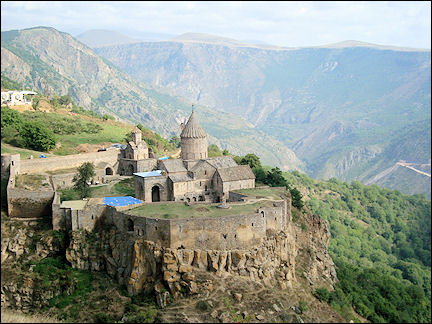
|
Armenia has an abundance of churches and monasteries: the Geghard monastery with its church carved into a rockwall; the walled-in Tatev monastery; the Haghpat, Sanahin, Noravank, Khor Virap monasteries and the Sevan monastery on the huge Lake Sevan. But Armenia has more to offer: the first century Temple of Garni; the caravanserai in Selim; the canyon near Khndzoresk; and Vayots Dzorm, a 6,000 years old circle of basalt rocks; rough mountainscapes; and its capital Yerevan.
Travelogue & photos: Marianne Komen
Alla is waiting for me on behalf of the travel agent at the exit of Zvartnots International Airport, 12 kilometers from Yerevan. The chauffeur gets the car and within 15 minutes we arrive at my B&B in Yerevan. Alla hands me a map of the capital of Armenia and some additional information.
Cascade Memorial of Yerevan
Stairs, sculptures, ponds and flowerbeds
After breakfast at a large, oval-shaped table with beautiful china and silver cutlery - as if I am visiting my mother - I want to see the Cascade. I walk down Mashtots Street, with ugly buildings and lined with trees. Traffic zooms by on a four-lane road.
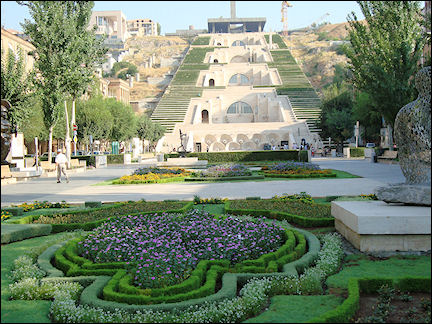
|
At the entrance of the park in front of the Cascade stands a large statue of the architect Alexander Tamanyan. On both sides of the beautifully landscaped park are contemporary statues worth seeing.
The Cascade is a memorial from the 1970s, in commemoration of the fiftieth anniversery of the Armenian Soviet Republic. It has two rows of white stairs that lead via terraces to a hill top. The stairs are lined with flowerbeds. Each terrace has a wall with sculptures and a pond.
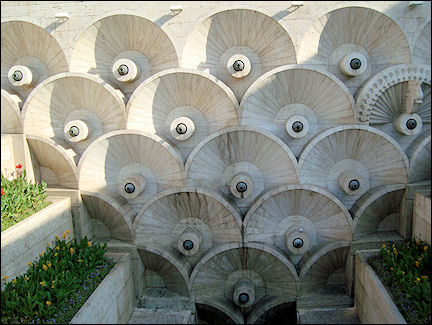
|
It's rather hot and I arrive at the top panting. The view of Yerevan here is like that of any city: lots of buildings, not very spectacular. I see you can also get here by escalator, at the other side of the building. Few tourists use it, but construction workers do.
Geghard Monastery
The seventh century church is carved into a rock wall.
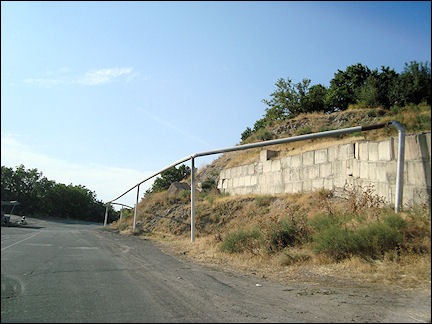
|
In the afternoon the chauffeur leads the car through the busy traffic, which seems chaotic; we are passed left and right. Outside the city are lots of - because of the financial crisis - unfinished buildings.
We pass through diminutive villages, where people sell fruit and jam in booths along the road. The gas mains run above ground. The mountains make it hard and earthquakes make it unsafe for underground gas mains.
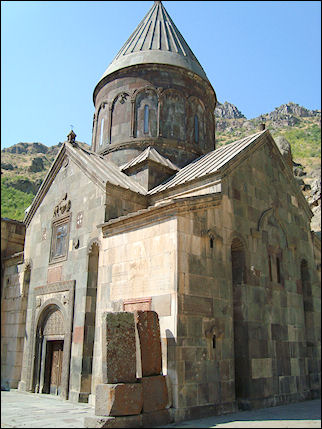
|
Garni, 28 km south-west of Yerevan, is a larger town. The landscape is bare and hilly. The hills are covered with dry, yellow grass, which makes them look desolate. Near some of the houses grow trees. In the distance lies Mt. Ararat, shrouded in mist, with perpetual snow on its peak.
Every now and then some cows wander imperturbably along the road, grazing the scant grass. We see workers on a mountain. The guide tells us that part of this mountain came down in a landslide. Fortunately it happened at night, so no one got hurt. The workers are now busy to clear the debris.
We arrive at the Geghard monastery compound, which is on the Unesco World Heritage List.
The original seventh century church is carved into a rock wall and has great acoustics for singing. Until the thirteenth century a number of additions to the church were built outside the rock face.
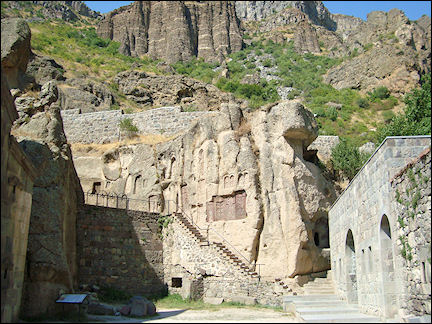
|
Most churches in Armenia have four supporting columns and a round, pointed dome in the middle. Often there are also twelve smaller columns (symbolizing the twelve apostles). The altar sits on a platform and has stone steps on its side. Churches have small, high windows because of potential attackers.
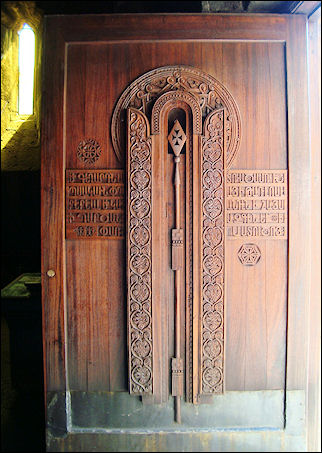
|
The newer church has a large wooden door in which a spear is carved out. The church has many reliefs in its walls, crosses and patterns. The dome is decorated. In this church the spear is kept with which Jesus was pierced on the cross.
The spear was later moved to a museum in Echmiadzin. The Hofsburgmuseum in Vienna also has the "same" spear of Longinus and there is a splinter of the spear in the Saint Peter basilica in Rome.
As usual around tourist attractions there are stalls outside. I try a piece of fruit lavash: crushed fruit (f.i. berries) that has been dried and pressed. It's tasty and I buy a piece for a few cents.
Temple of Garni
The first century Roman temple is completely restored
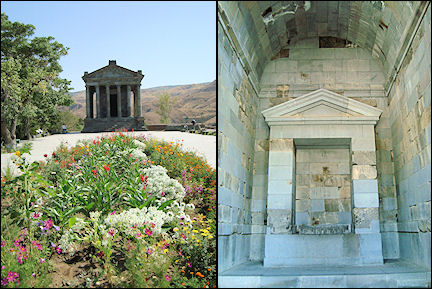
|
We return to Garni where we visit the Roman temple, built in the first century by King Tiridates. The nearby palace used to be his summer residence. It was severely damaged in an earthquake in the seventeenth century. Only in 1970 it was restored to its former glory.
The building is smaller than I thought. Between the remains of the palace, fragments of mosaics are visible in the bathhouse and also a water heating contraption.
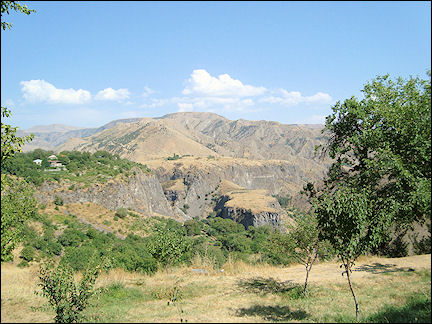
|
We prepare for a day of easy hiking: we don our caps and bring water. The first leg is easy indeed, until we reach a sheer drop. The path is covered with rough gravel, which makes it slippery.
Back at the foot of the hill I rest my legs on a bench with the Garni river behind me. Fortunately the rest of the path is easy, even though it's really hot, without a breath of wind. We walk through a canyon between beautiful basalt mountain walls with columns and blocks.
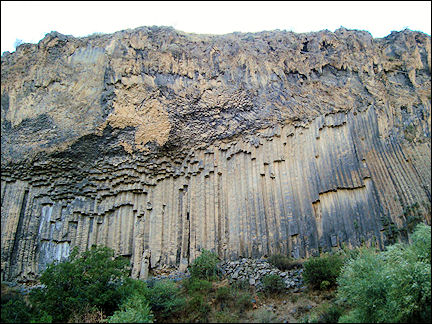
|
Rusty iron benches with awnings over them, intended for picnics, sit along the river. After walking in the heat for an hour, the dessert comes into view: to our left and right are impressive mountains with countless basalt columns and blocks. This formation is sometimes called "Symphony of Stones".
After a short climb the car is waiting for us to take us back to Yerevan. I am glad it has air conditioning.
Spitak
A major earthquake made 25,000 victims
The next morning we travel to Dilijan in the northeast of Armenia. We pass a field that displays the Armenian alphabet in steel.
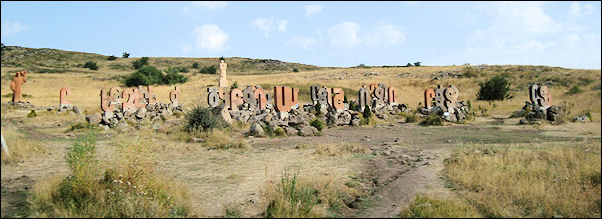
The monk, theologian and linguist Mesrop Mashtots designed the Armenian alphabet in 405. The 36, one-meter-high letters were placed on this field because of some kind of anniversary.
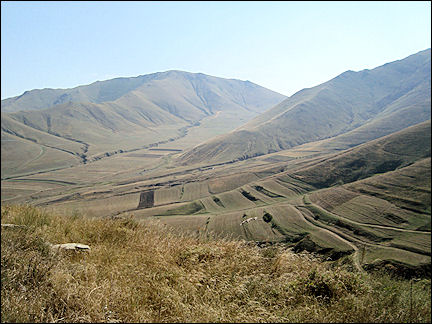
|
We drive in the Spitak region that was hit by a severe earthquake in 1988, which killed 25,000 people. Apart from remains of factories, empty steel shells, there isn't much to be seen of the damage anymore. There is an Italian district, built with financial assistance from Italy, which is recognizable by its red roofs.
Near the city of Spitak, on a low hill, sits a church made of tin, next to the cemetary where the victims of the disaster are buried.
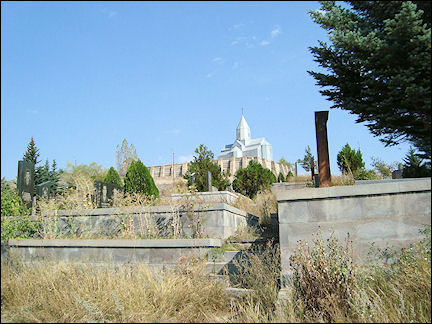
|
We drive between mountains covered with trees. The landscape all of a sudden changes. There are stalls along the road again, now with tomatoes, grapes and vegetables.
On the way we buy some rolls for lunch in a bread factory. Workers are standing by large machines. A man is scrupulously weighing dough. Women are busy with large pieces of dough. I see a lot of empty bottles. It's necessary to drink a lot, it's very hot in here.
Haghpat and Sanahin monasteries
Books and food were kept in holes in the ground
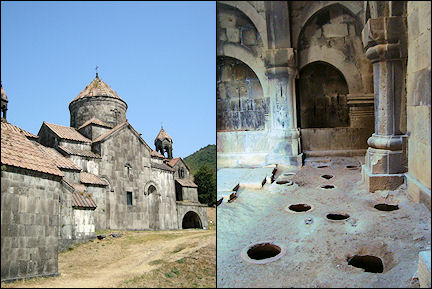
|
After a long drive we arrive at the tenth century Haghpat monastery, high up in the mountains. The monastery has a church which dates from 966, the St. Nishan cathedral from 967 and the St. Gregory church from 1005. The freestanding belltower with three floors dates from 1245.
I see many wall reliefs here as well and khachkars, memorial stones (steles) with carved-out crosses at their center, surrounded by botanic motives like rosettes and grapevines.
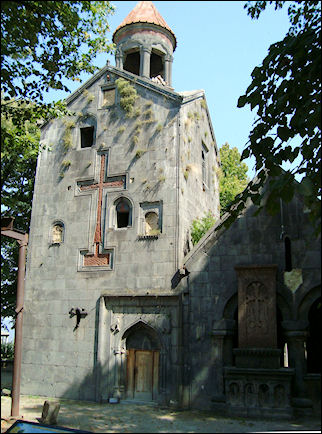
|
The floor of the church is covered with old tombstones. The library has holes in the floor: at some point, the monks discovered that books remained better preserved below ground. The holes were covered, which also was convenient when there were enemies in the neighborhood. The monastery was often attacked and damaged through the ages.
When we continue on to Alaverdi we see goats in the distance, high on a mountain. We pass through the village of Alaverdi, which has a small copper factory. The village is visible from a distance by its large stone chimney. We take a break in a restaurant, which doesn't have one big dining room, but several smaller ones.
We arrive at the Sanahin monastery, built in the same era as the Haghpat monastery and also on the World Heritage List.
Inside the belltower is a large relief of a cross. In the church are many tombstones with pictures. Laura, our guide, shows me a small stone and tells me it doesn't cover the tomb of a small person, but it had to be small because of lack of space.
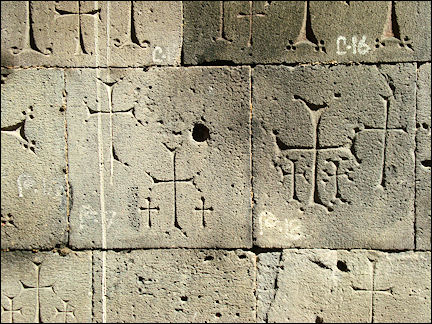
|
Between the belltower and the church a gallery was built to support both buildings in case of an earthquake. The gallery was later used as a classroom for boys. It had twelve seats, symbolizing the twelve apostles. On the grounds is another gallery between two buildings, also for support.
Crosses are scratched into the outside walls. This was done by pilgrims. An early form of graffiti.
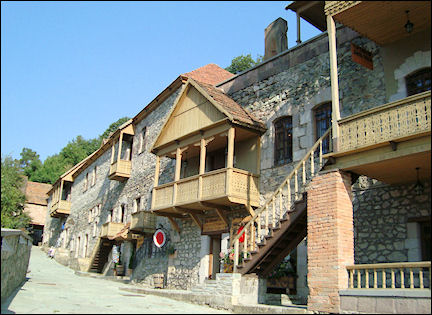
|
We drive back to the town of Dilijan. The hostess of the B&B half-way a mountain road, gives us a warm welcome and shows me my quarters: a kind of living room, connected to a bedroom. Its design is very old-fashioned, but that has its charms.
The village has a street that was restored in 19th century style. There are lots of small shops that sell souvenirs and pottery.
Sevan monastery and Lake Sevan
The monastery used to be in the lake, now it's by the lake
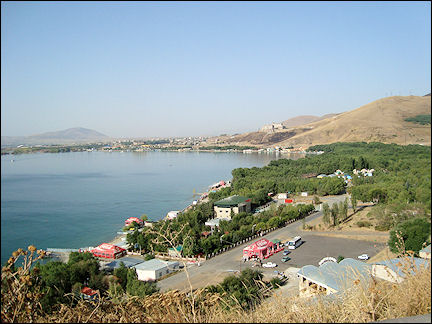
|
Breakfast is served in the garden on a rickety table with even worse chairs, but that doesn't bother me. The September weather is wonderful, the bread is still warm and the cheese and home-made jam are tasty.
We meander farther up the Caucasus mountains to Lake Sevan. At an altitude of 1,900 meters, this is one of the highest lying lakes in the world. Due to human intervention, it is 20 meters lower than it was in the 1950s. Nowadays it is 80 kilometers long and at its widest 30 kilometers.
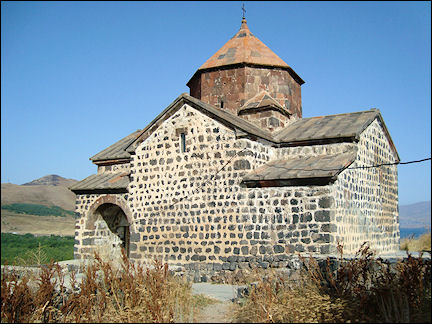
|
In the past, the Sevan monastery stood on an island in Lake Sevan, but because of the falling water levels it now sits on a peninsula. To get there, we have to climb 235 steps. Fortunately there are terraces every now and then where you can catch your breath. On some of those terraces artists are selling paintings and wood carvings.
There are two churches, Sourb Arakelots (Holy Apostles) and Sourb Astvatsatsin (Mother of God). The lower parts of the churches are made of basalt, the upper parts of tuff. Outside are some khachkars (cross-bearing memorial steles) which are worth seeing. We enjoy the view of the lake.
Caravanserai of Selim
The ancient bridges were part of the Silk Route
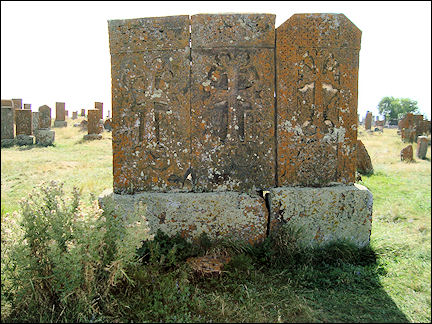
|
We travel on to Noratus. On the way there is a detour, which means we have to drive on a windy, almost inaccessible road. We sway from left to right to avoid the many potholes. Oncoming traffic does the same and it's exciting every time to see how both cars move to the side of the road at the last moment, so they can pass each other.
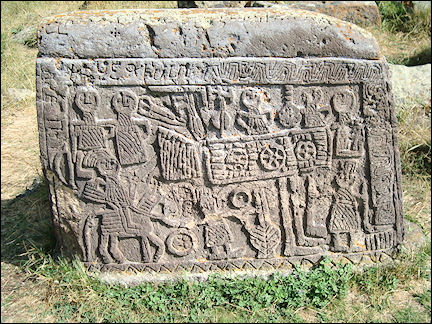
|
In Noratus we visit a cemetary with a large collection of khachkars. Guide Laura takes me to the oldest ones. Some of these stones are shaped like coffins with on their sides scenes of a party or an elephant caravan.
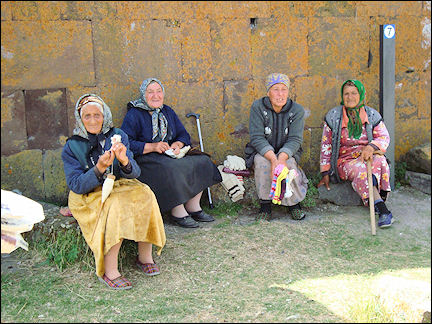
|
Some ladies sit near a delapidated chapel with colorful knitted caps, socks and gloves. I buy a pair of knitted woolen gloves from the oldest lady (82). While she gets the change, the other ladies try to sell me some more. Eventually they sit down neatly next to each other for a picture and wave me goodbye.
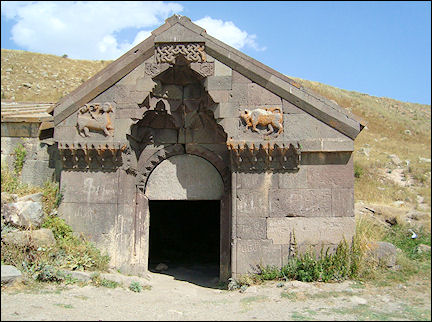
|
High up in the mountains we drive along spectacular vistas to the caravanserai of Selim. In the Middle Ages it was part of the Silk Route. This caravanserai isn't very big and nothing there has changed since the 14th century.
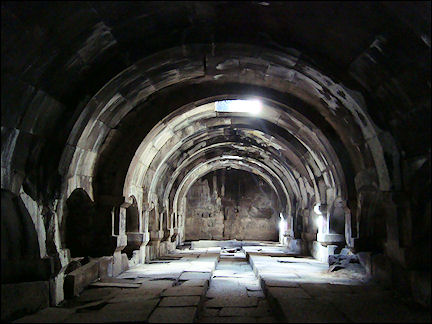
|
This place to spend the night for caravans has a big entrance with to its left a large space with with places to sleep for the humans. The troughs for the animals separate the sleeping space from the rest of the room. Travelers exchanged news here, told each other about the dangers on the road and warned each other for highway robbers.
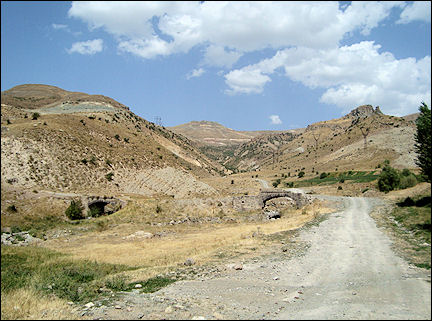
|
When we drive back down, we see some bridges that used to be on the Silk Route. It's hard to imagine how people with their animals found their way on those very narrow paths. The animals were usually horses and donkeys instead of camels, because of the mountains in Armenia.
Goris
The canyon at Khndzoresk is reminiscent of Cappadocia
It's another 100 kilometers to Goris, today's destination. We pass through little villages with trapezoid haystacks next to the houses. School's out and children walk home on the road, the girls in black skirts and white blouses and white ribbons in their hair.
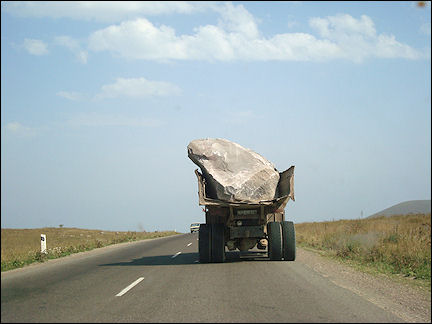
|
The mountainscape gets rougher, there is little overgrowth and sometimes the rocks have weird shapes.
We drive on the highway to Iran. We frequently pass crooked trucks with Iranian license plates. A worn-out truck with a huge rock drives in front of us.
Just before we arrive in Goris we pass a triumphal arch that sits on the side of the road. Here I see the city, in a valley; the houses look like doll's houses from this altitude.
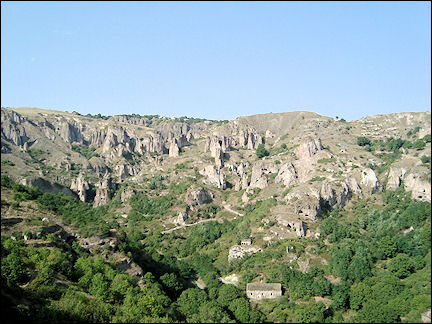
|
We drive around Goris and turn onto an extremely bad road just past Khndzoresk. Countless bends later we arrive at a steel platform where we have a great view of a canyon with lots of caves and typical rock formations on the other side. It reminds me of Cappadocia in Turkey, even though it's much rougher here.
We slowly bump back and the driver sighs with relief when we are back on a regular road. The owner of the B&B in Goris speaks English and welcomes us enthusiastically. The interior of the house is modern and the owner proudly tells us he made everything himself.
During an evening stroll I walk past a military looking building. A garrison is encamped here. Goris is close to the border with Nagorno Karabach, a disputed region which is now under Armenian control. The border with Azerbeidzjan is still closed because of this conflict and sometimes there are shooting incidents. The main street in Goris is a busy connecting road with Iran.
Tatev monastery
The ninth century complex is surrounded by fortifications
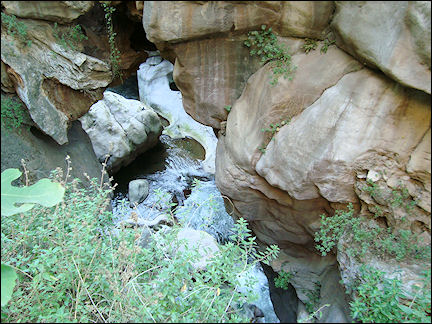
|
On the way to Tatev we pass the Devil's bridge, a natural bridge over the canyon between Tatev and Arzhis. The Vorotan river flows deep below the 50 centimeters wide and 30 meters long bridge. Next to the bridge are two ponds with warm mineral water.
The huge rocks have strange shapes and various colors, among which a beautiful shade of green. Near the bridge water streams from a rock.
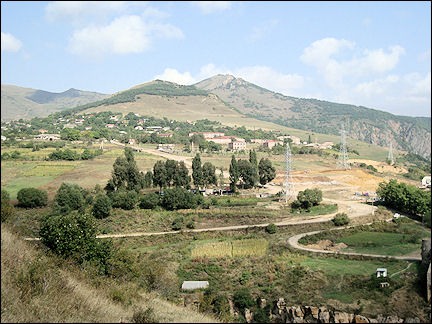
|
The road winds up the mountains to an altitude of 2,400 meters. We first drive past the Tatev monastery, in order to take a look at it from above. The ninth century monastery is surrounded by 17th century fortifications.
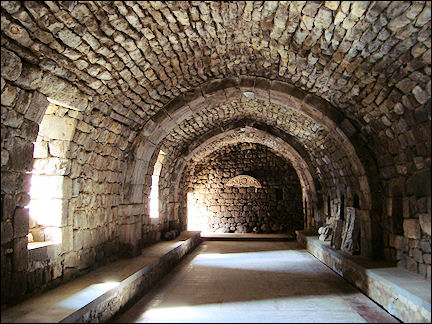
|
A little later we walk through the complex which has a Peter and Paul church, a large dining hall and bedrooms. Laura tells me that Tatev used to be an important center of education, culture and politics in the Syunik district.
There is a "swinging column" on the grounds, which sways during earthquakes. Research has been done into how this is possible, but an answer hasn't been found so far. The column was repaired badly of the research and now is reinforced with iron bands.
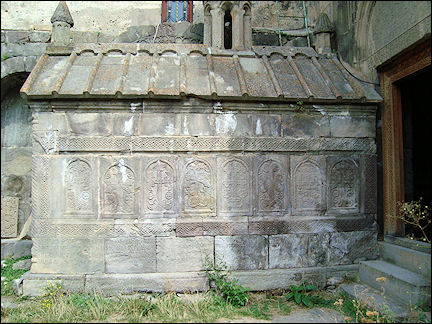
|
Inside the Peter and Paul church is a mausoleum, but nothing of interest is in it. The outside is pretty, with ornamental borders and crosses.
We slowly drive back down and have lunch in a hotel in Goris, after which we leave the town.
Vayots Dzor
A 6,000 years old circle of basalt blocks
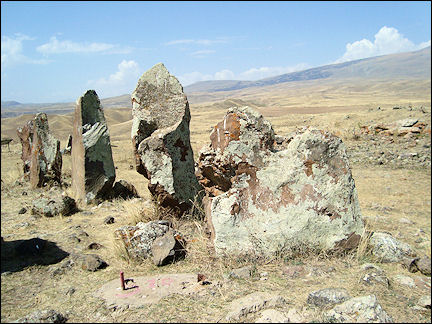
|
We drive to Sisian to visit Zorats Karer, three kilometers further, an about 6,000 years old collection of 260 basalt blocks. The blocks are arranged in a circle and are overgrown with moss. One theory states that it used to be an astronomical observation post. A shepherd with a large herd of sheeps wanders on the grounds.
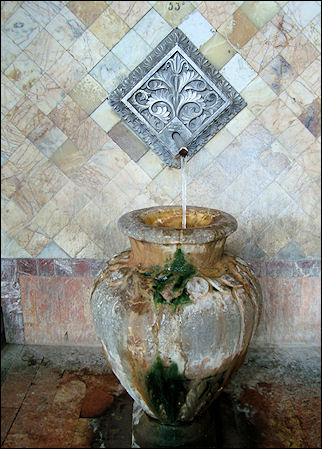
|
We leave the Syunik region and pass Saravan, where the mountains are higher and wilder. We drive through the Vayots region to Jermuk, which has many hot water sources. We stop at a hotel cum health spa. Next to it is a gallery with four tubes in the wall, from which flows water of 20-53 degrees centigrade. I see people drink this water. It is supposed to be beneficial. Opposite the hotel is a lake surrounded by restaurants.
A little later we arrive at the waterfall of Jermuk. The Vorotan and Arpa rivers merge here and crash down in a waterfall. In spring, when the snow melts, there is more water, but it's still impressive. The rocks are rough and beautifully overgrown with moss in different colors. There are some other tourists at the Jermuk waterfall. At other sights we always were the only visitors.
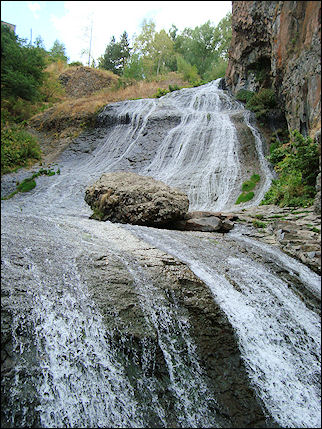
|
In the village of Shatin we are greeted by a man who leads us to his house. He built an observation post for spotting wild goats that live on the mountain opposite his house. He gives us binoculars and after a lot of pointing and searching, we see something move in the distance, high up in the mountains. The man tells us that the goat population has increased since the area became a protected nature reserve. There are also bears and foxes there.
The hotel in Yeghegnadzor is brand new and I think we are the first guests. The small restaurant next to it has no menu, just like the others we visited. So Laura, my guide, asks me what I want to eat. It takes some back and forth before I can make a choice.
Noravank and Khor Virap monasteries
Gregory the Illuminator spent 13 years in a dungeon here
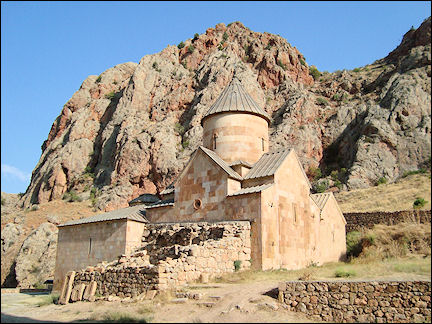
|
Not far from Yeghegnadzor we drive through a canyon with high mountain walls on both sides. At the top of one of those mountains I see the 13th century Noravank monastery. Its church was damaged in an earthquake, so the current one is of later date than the smaller one behind it. This monastery had a university, just like Tatev, only smaller.
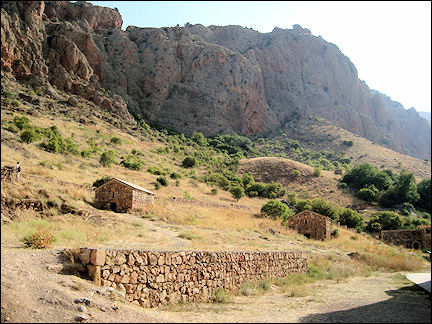
|
The large church has two floors. Outside and inside the church are tombstones, on one of them is a picture of a lion. There is a big hole on the property, surrounded by a fence. It gives access to a tunnel, an old escape route which leads to the foot of a mountain. The monastery is surrounded by rough red rocks and again the views are fantastic.
We arrive in the province of Ararat, the hottest part of Armenia. The landscape is flatter and there are vineyards. There are lots of stalls along the road with grapes, pumpkins and wine. These stalls have remarkable reed covers.
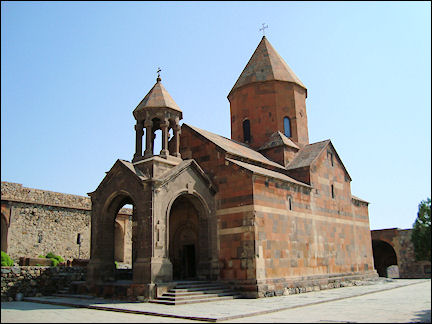
|
The Khor Virap monastery has fortifications around its property, just like the Tatev monastery. The current building dates from the 17th century. The monastery is a popular place of pilgrimage in Armenia.
According to legend, Gregory the Illuminator was jailed here for 13 years at the end of the third century, until he succeeded in converting the Armenian King Tiridates to Christianity and Armenia became the first Christian state in the world. A narrow staircase lead 6.5 meters down to the dungeon. For the first time I see images on the walls of an Armenian church.
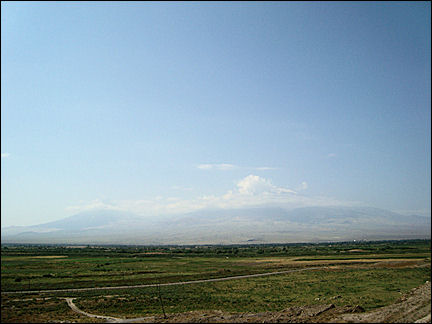
|
Outside I have an incredible view of Mt. Ararat, which now lies on Turkish territory. Too bad it's hazy. Below us is no man's land that can only be entered with a special permit. The border with Turkey is visible from here, but it is closed. On the other side is a valley with agriculture.
Yerevan
Stalls that sell almost everything are all over the place
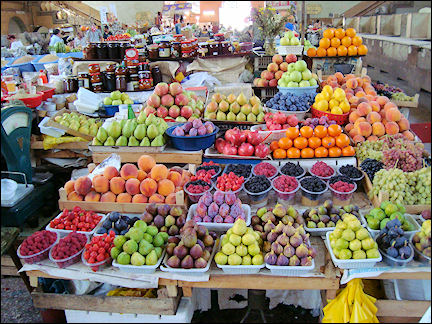
|
Back in Yerevan, where our tour began, we visit the indoor market. It's not very big and the merchandise is mainly vegetables and fruit.
It's very hot in the city. In the National Museum on the Square of the Republic I take an extremely narrow elevator to the upper floor. The museum has floors with Russian art, Armenian art, a department of enlarged, copied frescoes from Armenian churches and also art from other countries. It's worth seeing, but I expected more.
The St. Gregory the Illuminator cathedral was built in 2001 in honor of the 1,700 years anniversary of Armenian Christianity. I don't like it, neither outside or in.
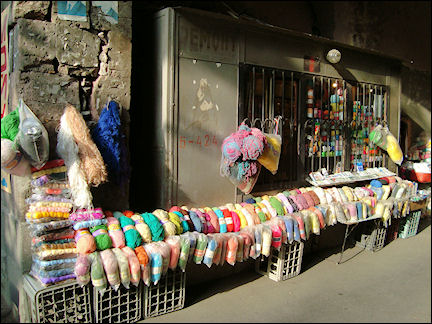
|
The street to the left of this church is more fun. Small stores and many stalls that sell about everything: birds, shaving necessities, underwear, pumpkins, wool, vegetables and spices.
I see a woman with a yellow cart who sells a drink to passers-by. I ask her what it is, but I don't understand her answer. Laura tells me later that it's kvass, a drink made of water, rye flour and malt. Later I see a lot more of these carts.
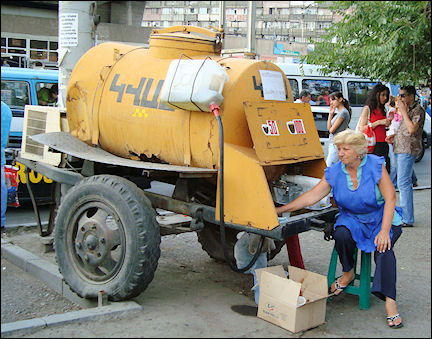
|
The streets of Yerevan are busy. People walk by and the noise of the busy traffic is loud during rush hour. It's as if people must honk whenever they pass another car.
You can cross the road via an underpass. In it are lots of small stores. On the other side I arrive at a market. There I see cognac (brandy) in the oddest bottles, like the ones shaped like crosses. There are also tons of candy and cookies.
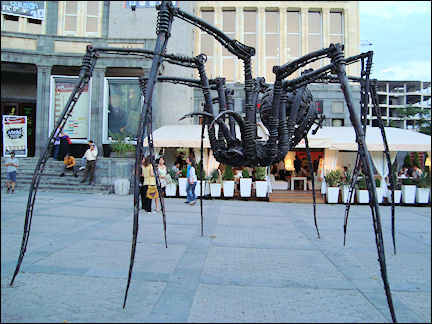
|
I walk back to the Square of the Republic and there I take a pedestrian street. At its end I arrive at the Opera. On a stage in front of the building, groups of children are performing folk dances. It's nice to watch, but the music is way too loud.
After dinner I wander a little more. I arrive at the Moscow Cinema; on the square in front of it are two animal sculptures: a bull and a spider.
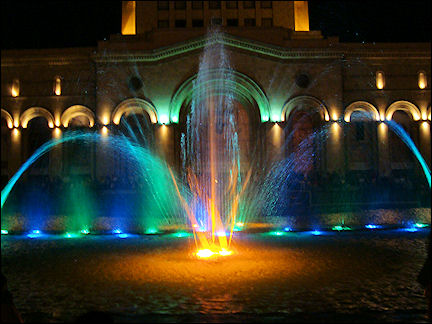
|
It's time for the dancing fountains show, so I return to the Square of the Republic. It's very crowded there. Exactly at 9 PM the fountains, illuminated in different colors, begin to spurt on the rythm of music. Yellow, green, blue, red and orange alternate.
The water spurts in archs, higher, lower, then again in a circle. Sometimes the water gushes so high that the audience gets wet.
Echmiadzin and Zvartnots
Allright, a few more churches and monasteries
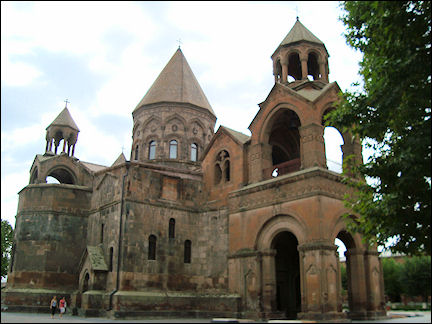
|
I am actually tired of all those churches and monasteries, but on my last day here we vist a few more. In Echmiadzin, a little north of Yerevan, we visit the Saint Hripsime church. This church has a small, seperate room for women, from where you can just see the altar when you kneel.
We drive to the complex that is the seat of the head of the Armenian-apostolic church, the katholikos. It has several buildings, among which a seminary, a residence of cardinals and one for the katholikos him self. It's a well-maintained property with small flowerbeds.
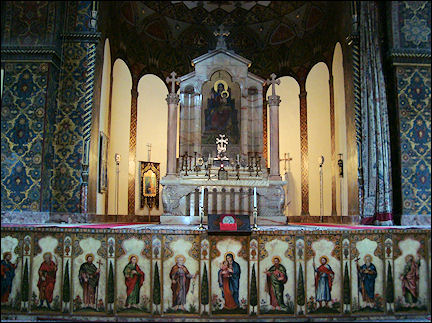
|
The original church, Mayr Tachar, dates from the fourth century, but it was completely rebuilt in the 15th century. The entrance is lavishly decorated. Inside is a large altar with paintings on its front. The chair of the katholikos, with gold and silver, stands to the side.
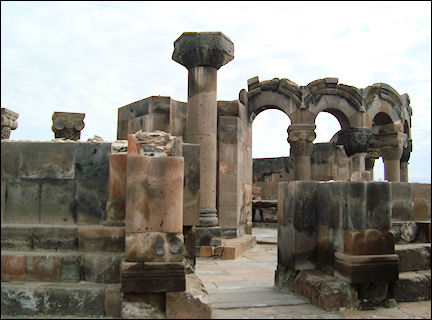
|
To the right of the altar is the entrance to the treasury. A young guide leads me along the relics: some glass cases with silver lower arms, containing bones of apostles; a silver cross with a piece of Jesus' "original" cross at its center; the spear with which Jesus is supposed to have been pierced. There also is a collection of chasubles.
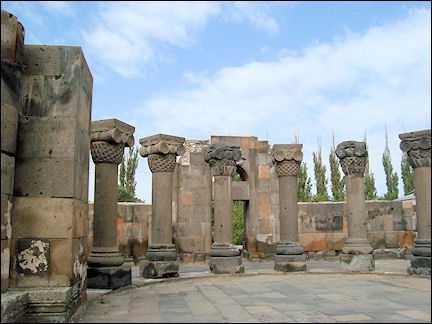
|
We leave the Mayr Tachar for Zvartnots, the ruins of a seventh century Byzantine cathedral that was wrecked by Arab armies at the time. The ruins were discovered under the sand by coincidence early in the 20th century. There is a circle of columns and around it remains of archs and a huge sun dial.
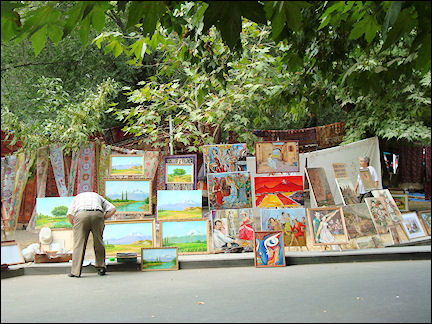
|
Back in Yerevan I am dropped at the Saturday market. I take my leave of my guide Laura and thank her for all her explaining and help during this trip. I am amazed at the variety of merchandise on this market: rubber rings, dentist's equipment, jewelry, CDs, sheet music and of course souvenirs. Next to the market artists try to sell their paintings.
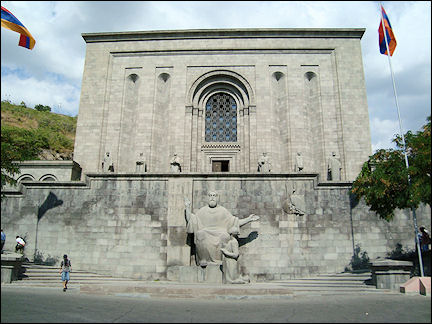
|
It's very hot again. I take a cab to the Matenadaran (Armenian for "repository of manuscripts") where handwritten manuscripts dating from 1100 and older are on display. And here I see other tourists! The staff is not paying attention at all and they are having a nice chat with each other.
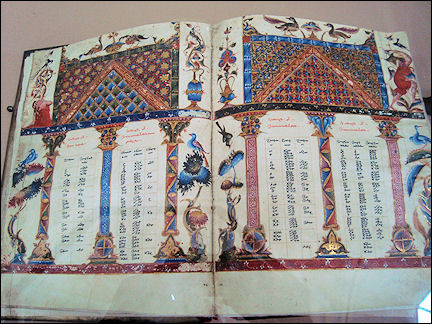
|
The manuscripts are incredibly beautiful and have amazing colors. Some books have silver covers which are works of art by themselves.
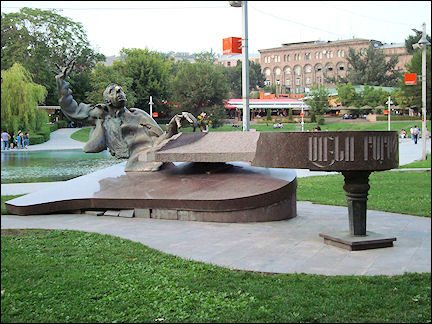
|
After this visit I just wander through streets. By accident I discover a diminutive church between residential buildings. It is the Kathogike and actually it's more like a chapel. The rest of the church was torn down by the Soviets. I frequently see people enter for a short prayer.
Eventually I arrive at the Opera. In the park that surrounds it, is a modern statue of a pianist with a grand piano. It depicts the famous Armenian composer Arno Babajanian.
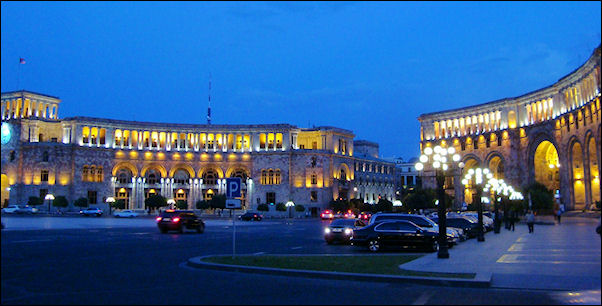
On my last night in Yerevan I take a walk after dinner. On the Square of the Republic the tuff building with belltower of one of the ministries and some other buildings are wonderfully illuminated. An atmospheric goodbye to Armenia.